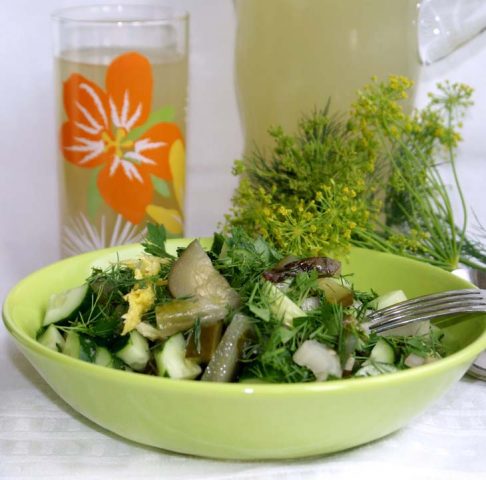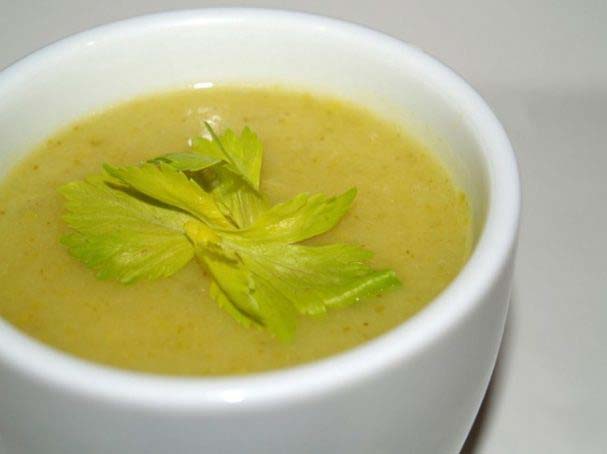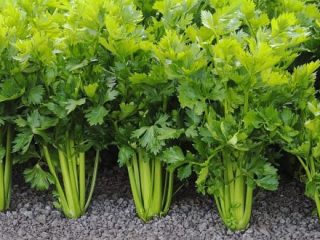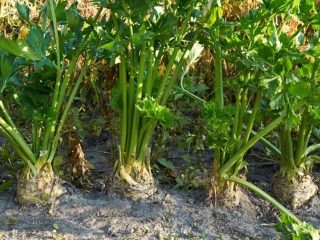Content
Some resourceful agronomists know about a rare crop - leaf celery, which is planted in boxes in early March in order to introduce one of the most useful plants into the diet throughout the year. The benefits and harms of leaf celery should be known to everyone.
What does leaf celery look like?
Unlike the two types of celery, root and petiole, leaf celery produces a large volume of leaves. Its root is thin, growing deep into the ground. The leaves grow from a rosette. This is the structure of the leaves when their base is closely intertwined and resembles a bush. The leaves are the edible part of celery, visually reminiscent of parsley, they are the same fluffy, have a similar density, color and location on the stalk, but differ in smell and taste.
Other features, the height and number of leaves on the rosette, depend on the variety.For example, the “Samurai” variety grows up to 65 cm and has a fluffy bouquet of leaves, while the “Zakhar” variety, on the contrary, has a height of up to 36 cm and has fewer leaves, but it ripens faster. The “Local” variety also grows up to 65 cm, but its density cannot be compared with any other; from 1 m² you can harvest 3 kg of crop.
Leaf celery - annual or perennial
Since the leaf version of celery has a small root, the plant lives only 1 year. The next year, it is necessary to plant the seedlings again on the windowsill and replant them in the ground after a month. Other types of celery are grown for the root, so they are completely ripped out, leaving nothing in the ground. There is only 1 type of this plant, which is planted once for 10-15 years. It is called Lubistok, also known as the Piper, or Zorya.
Do you eat celery leaves?
Celery leaves are eaten as an independent product. It is added and prepared in a variety of ways. They dry it for the winter, grind it in a blender, drink it as juice, bake pies, freeze it, add it to preserves, and make smoothies. There are many recipes for preserving and preparing these aromatic greens. The most common use of the leafy product is cutting it into a vegetable salad.
The health benefits and harms of leaf celery
Any greenery is popularly considered a healthy product. Leaf celery is known for its restorative properties and positive effects on the male body. For adenoma and impotence, special healthy recipes are prepared from honey and other fruits mixed with juice from celery leaves. There is no harm in using these recipes daily.
When losing weight, juicing leaf celery and other fruits and vegetables is very popular.Due to their minimal calorie content and rich content of useful elements, such drinks give strength for the whole day, removing toxins from the body with the help of the fiber contained in the plant.
Celery leaves are high in sodium. Due to its ability to remove excess fluid from the body, it is not harmful to people with hypertension. The plant is also known for its ability to eliminate cholesterol from arteries and blood vessels, which is also necessary for those suffering from high blood pressure.
Various herbs, including celery leaves, cleanse the blood and enrich it with oxygen, resulting in increased vigor and a surge of strength. Therefore, the greens of this plant are consumed with low hemoglobin.
Harm can occur if you use the product a lot and every day. Frequent consumption of celery juice on an empty stomach increases acidity and leads to gastritis. When taking greens for medicinal purposes, when it is important to take it on an empty stomach, you should drink no more than three tablespoons at a time. Otherwise, everything depends on individual intolerance, the presence of chronic diseases and allergies.
Composition of celery leaves
Celery leaves contain a wide range of vitamins, making it one of the healthiest foods, along with nuts and legumes. It is for this reason that this plant is valued among vegetarians who prefer live food. Chemical elements found in the foliage and stem include:
- potassium;
- calcium;
- iron;
- sodium;
- phosphorus;
- magnesium;
- purine
Leaf celery has essential oils, oxalic and chlorogenic acids, vitamins B, C, E, A and beta-carotenes. The nutritional value of the product per 100 g is 13 kcal, including 0.9 g of protein, 0.1 g of fat, 2.1 g of carbohydrates.
How to eat celery leaves
Taking the product is effective in its raw form. It must be remembered that heat treatment, cooking, baking reduces the amount of useful elements. Celery can be dried and frozen for the winter. The culture has a lot of vitamin C, which is necessary for the immune system and blood vessels. 100 g of product compensates for the daily requirement of vitamin C, beta-carotene and vitamin A.
The beneficial properties of leaf celery include essential oils that stimulate the nervous system. Therefore, it is useful to eat it in the morning to perk up, unlike coffee, which is contraindicated for people who have pressure changes during the day.
For constipation, you need to drink celery juice diluted with water 1:10. Its strengthening effect is useful even for nursing mothers whose children suffer from poor intestinal obstruction. With mother's milk, the baby will receive the diluting elements of this vegetable crop.
It is beneficial to drink celery juice before meals because it stimulates the appetite. Taking the culture before meals has a beneficial effect on the kidneys during the inflammatory process and reduces pain from cramps during menstruation.
Leaves, ground with honey, are taken for prostate disease. This recipe is made from equal parts honey and celery, taken 2 tablespoons three times a day. The product should be stored in the refrigerator.
Healthy and tasty recipes
Leaf celery is a flexible plant and goes well with almost everything except sweets.You can sprinkle herbs on any soup or vegetable salad. It's worth considering a few simple recipes using leaf celery that you can prepare every day.
Flatbread with celery
This original Armenian dish is very low in calories due to the presence of herbs and spices as the main ingredients. It can be prepared in 1 hour, preparation time will take 40 minutes.
Ingredients:
- 400 g flour;
- 1 glass of water;
- 120 g celery leaves;
- 120 g cilantro;
- 100 g green onions;
- 100 g garlic feathers;
- 100 g salad;
- 80 g spinach;
- 80 g sorrel;
- 50 g dill;
- 80 g vegetable oil;
- salt and pepper to taste.
Cooking method:
- Mix flour, water, salt, make a thick dough, cover with film and let stand for 30 minutes.
- Cut all the greens or grind them in a blender, add salt and pepper.
- Cut the dough into 6 equal parts, roll out to a thickness of 1 mm.
- Add the herb filling and form into pies.
- Fry the flatbreads in a frying pan until the dough is ready.
The set of greens can also include dandelion leaves, radish and beet tops, and nettles.
Banana salad with apples and celery
This lean, but high-calorie dish can be prepared in 15 minutes. All products remain fresh and cannot be cooked. In the summer, it is a quick snack with a minimum of effort.
Ingredients:
- bananas;
- apples;
- tomatoes;
- celery leaves;
- ground pepper;
- salad;
- mayonnaise.
Cooking method:
- Cut the bananas lengthwise into two parts without damaging the peel (it will serve as a plate).
- Finely chop the lettuce, tomatoes and apples, season with mayonnaise and mix.
- Spread on banana.
The dish is ready.
Summer kvass salad from greens
This dietary Jewish salad has a minimum of calories and a rich set of vitamins - what is needed for those who are on a diet. All ingredients are used fresh and can be added in unlimited quantities. You can both eat and drink the salad.
Ingredients:
- salad;
- celery leaves;
- parsley with dill;
- cucumber;
- apple;
- horseradish leaf, currant and cherry;
- 2 cloves of garlic;
- basil;
- sugar and salt.
Cooking method:
- Chop greens and vegetables not very finely.
- Place everything in a three-liter jar, leaving about half a liter of free space.
- Add salt and sugar 1 teaspoon each.
- Pour warm water and cover with gauze, leave to ferment for a day.
- After the allotted time, drain the kvass separately, discard the inedible leaves, and chop the edible leaves finely.
Serve chilled as hash or as a salad. You can add any greens, for example, cilantro, green onions, spinach.
Diet celery soup
This recipe is included in the set of dishes that promote weight loss. Cooking along with preparing the ingredients will take half an hour. The soup contains products that have cleansing properties, so their combination is useful for people undergoing rehabilitation after surgery.
Ingredients:
- 1 bunch of celery leaves along with the stem;
- 1 medium sized head of white cabbage;
- 5 tomatoes;
- 2 bell peppers;
- 3 onions;
- 1.5 liters of water;
- salt to taste.
Cooking method:
- Chop parts of celery, bell pepper and onion as desired.
- Peel the cabbage, remove the hard part of the cabbage, chop the leaves.
- Peel the tomatoes by dipping them in boiling water for a minute.
- Mix all the vegetables, add salt to taste and cook for 25 minutes over low heat.
Serve the soup hot.You can also make puree soup from it. To do this, you need to cook the vegetables whole, then remove them from the broth, put them through a blender and add broth again.
Green smoothie with apple and pineapple
This dietary drink, rich in plant carbohydrates, can wake up the body in the morning and give it strength until lunch. The calorie content per serving is 318 kcal, of which 4 g come from protein, 13 g from fat and 48 g from carbohydrates. You can prepare it in 15 minutes.
Ingredients:
- 2 green apples;
- celery stalk and leaves;
- 1 small cucumber;
- half a pineapple;
- half an avocado;
- 50 g spinach;
- a quarter of a lime;
- 150 g ice.
Cooking method:
- Cut cucumber, apple, celery and avocado into slices.
- Peel the pineapple and lime and cut them too.
- Pass everything through a blender, add ice.
You can add fresh mint, strawberries, raspberries and other watery fruits to the recipe. You can take the drink with you in the morning for a run; it refreshes and tones the body, normalizing water balance.
Contraindications
In addition to the beneficial properties of celery leaves, it has its contraindications. People with stomach ulcers and low acidity should not take greens in large quantities. It is also contraindicated in patients with hemochromatosis, in which the level of iron in the body exceeds the norm, and hyperkalemia - an excess of potassium, in which the heart muscle suffers. If you have kidney stones due to the presence of phosphorus in leaf celery, moderation should be used.
The purine contained in celery affects the deposition of uric acid, which is deposited in the joints in the form of salts.Therefore, people with gouty arthritis are not recommended to consume celery leaves. This also applies to those who are severely obese. For these people, it is necessary to eat foods that promote the removal of fluids rather than the accumulation that purine does.
Conclusion
The benefits and harms of leaf celery directly depend on the state of the human body and sense of proportion when eating. To understand the impact vegetables have on the body, you need to listen to your condition. This is a fairly strong plant that can have both a beneficial effect on organs and general well-being, and a destructive one.















